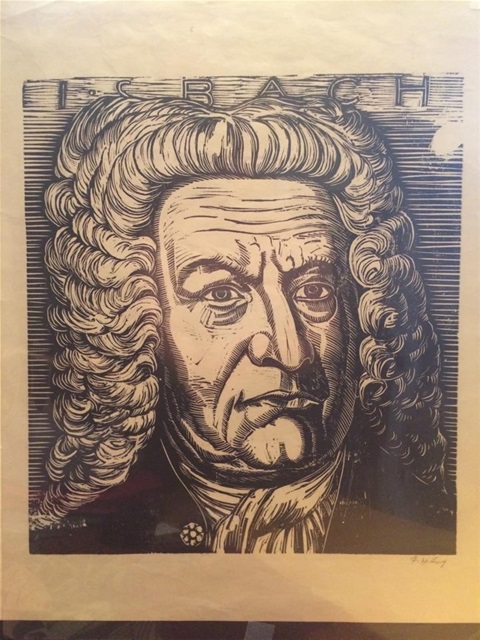The King and the Palindrome
A palindrome is a bit of a puzzle. In word play, it is when the letters of a word are reversed completely, and will spell the word the same way. A few examples are the word radar, kayak, or racecar.
A musical palindrome is just that ~ a mirror image of a musical passage, which when played backwards brings you to the same theme. We will get back to palindromes after I tell you a little bit about Bach.
Johann Sebastian Bach is considered to this day to be the Father of Music. Born in 1685, he was raised to become very religious, but was also a family man who raised 20 children; 7 from his first wife and 13 from his second wife. He held numerous positions as a Cantor, an Organist and a Director of Music, both in Churches and at Court, and was of course, a prolific composer, bringing mastery and enlightenment to the sound of Baroque music.
Bach was one of the first to believe that harmony could be derived ‘in the mind’ or be improvised, and was known as a master keyboardist who could improvise and easily experiment with new sounds or harmonies, and ideas. Bach notated much of his music with a ‘figured bass’ notation, giving a guideline of which chords to augment the bass line with. He wrote:
“Figured bass is a most perfect foundation for music. It can be played on the keyboard in such a way that the left hand plays the written notes, while the right hand strikes consonant and dissonant chords resulting in full-sounding harmony to the Glory of God and the delight of the soul. The ultimate goal of all music should be nothing but the Honour of God and the renewal of the soul. When this is not taken into consideration there is no true music.”
In studying the various Forms that music can take, we have learned that compositions can take the form of Contrast or Binary, Return or Ternary, Continuous Return or Rondo, and Variation. Within these forms, there are Subcategories, such as Ostinato, Through-Composed, or Permutative.
We already recognize different forms when they come in Cycles, ranging from a song that’s 4 minutes long, to a Cantata that is 20 minutes long, to a Symphony that’s 45 minutes long, or an Opera that’s 5 hours long.
Bach’s abundant writings, numbering to 1128, have been given a Catalogue numbering system, the BWV which stands for Bach-Werke-Verzeichnis. This makes the pieces easier to find and to identify. Let’s go back to the Cantatas…. Did you know that Bach wrote one for every Sunday of the Church Calendar? He even continued past the end of the calendar and continued anew! When put together, this remains one of the longest cycles ever written. In addition to Church Cantatas, he also wrote one about Coffee! [I had fun a couple of years ago producing a presentation of the Coffee Cantata with the Elixir Baroque Ensemble and a couple of great friends.]
Bach’s children were also very musical, and also held positions in Churches and at Court. His one son, Carl Philipp Emanuel Bach, held a position within the Courts of King Frederick II of Prussia. This King, who called himself ‘Frederick the Great’, summoned the truly great Bach to his Courts and challenged him to write a 3 part Canon, based on one of the King’s own compositions. Since the King considered himself to be brilliant, and he also believed that Bach’s polyphonic music was not as appealing as his own more simple melodies, he likely felt very smug asking Bach to improvise on his work. Bach’s response was to humbly sit at the piano and instantly improvise a 3 part Canon based on the King’s theme. A Canon is essentially a Round ~ we know a most common Round to be Row, Row, Row Your Boat ~ so now you get the idea of what Bach had to come up with, given an initial melody to work with.
Not to be outdone, the King then challenged Bach to write a 6 part Canon based on this same theme. Bach accepted, but asked for a few days’ grace, and left the Courts. One can imagine him bumping home in his stagecoach writing furiously in order to meet a deadline. However, some weeks later, Bach sent a score to the King which is largely regarded as a thumbing of the nose gesture. He had indeed composed a 6 part Canon based on the King’s theme, and he called it The Musical Offering, or in German, “Das Musikalische Opfer”, or BWV 1079.
Bach’s brilliant response was not only a 6 part Canon, but it was a complicated pattern using mirror images of the theme, repeatedly, which is now known as a Crab Canon and is most certainly a Palindrome. I can envision the modest, God-fearing family man that Bach was, presenting the King with his work ~ a King who found delight in humiliating others. How satisfying it must have been for Bach to quietly and triumphantly smile, his composition lasting an hour and posing a puzzle that likely took the King some time to solve. Perhaps he never did.
Here is a YouTube video of a group playing The Musical Offering. https://youtu.be/egxcMlHXY4I

Latest comments
This is STILL a perfect description of the worst president of the USA ever.
Keep sharing like this more with all of us.
I really like the stuff which ahds hared herea bout this place. I will try to go there after taking the tour by http://www.goldenbustours.com/.
My dear Kira, your poignant words touched me deeply. To know that you were treated like this is just unbelievable. Thank you for sharing.